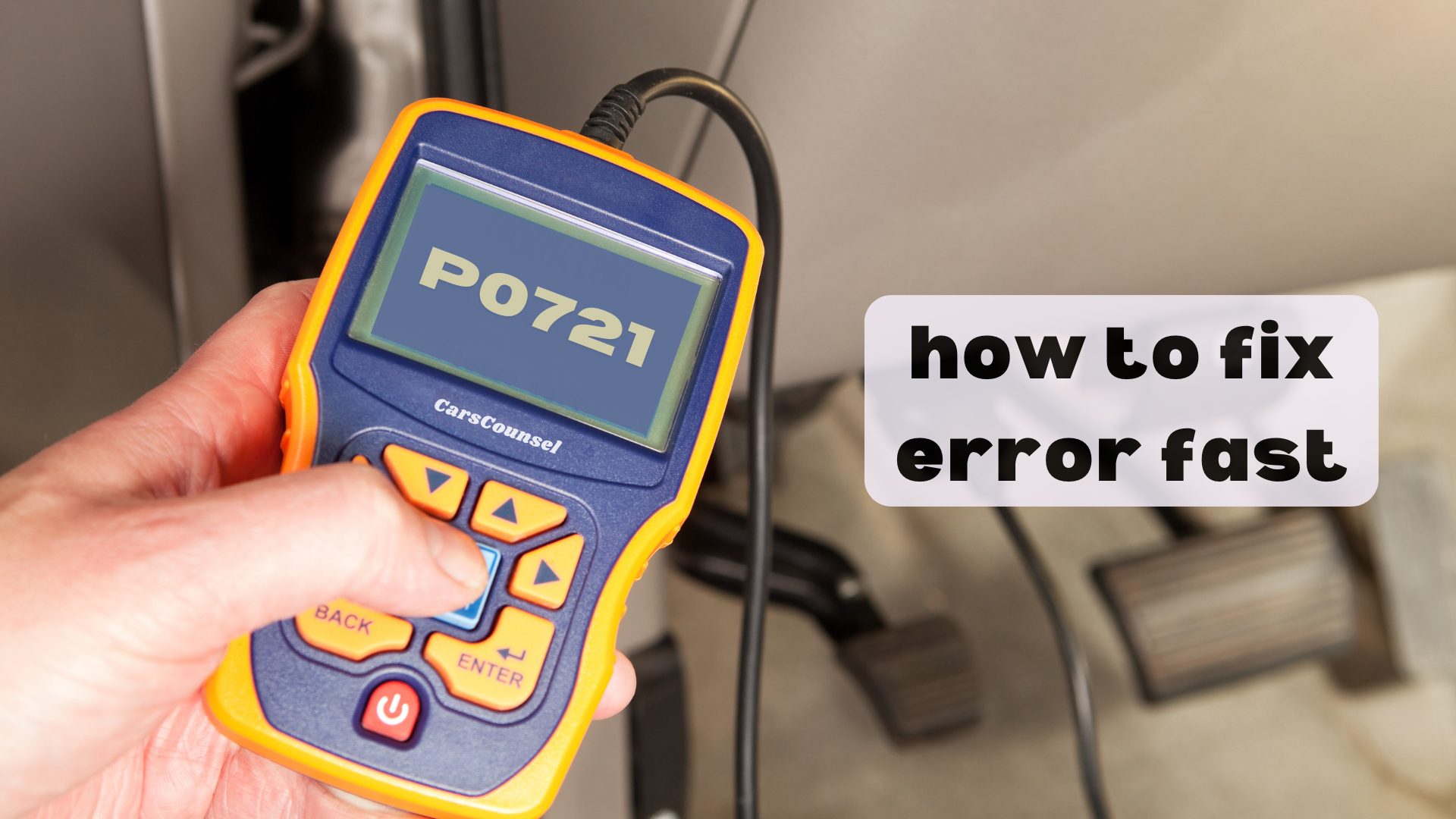When you see the P0721 code pop up, it means there’s a problem with your vehicle’s output shaft speed sensor, which can mess with your driving. Fixing this quickly is important to avoid bigger problems.
Start by using a scan tool to confirm the OBD2 code and gather data. Then, check the output shaft speed sensor, along with its wiring and connectors.
But how can you make sure your fixes work and stop this from happening again? Let’s look into the steps and best practices to tackle this issue quickly and effectively.

Quick Navigation
Key Takeaways
- Check and fix any damaged or corroded wires and connectors.
- Replace the bad output shaft speed sensor right away.
- Use a scan tool to clear the error code once you’ve made repairs.
- Make sure the transmission fluid is at the right level and is clean.
What Is P0721 Code
The P0721 code means there’s a problem with the output shaft speed sensor circuit, which tracks how fast your car’s transmission output shaft is spinning. If this sensor isn’t working right, you might notice your car shifting gears strangely, the transmission slipping, or even using more fuel than usual.
To figure out what’s wrong, start by using a scan tool to read the error code and other information from your car’s computer.
Then, use a multimeter to check the voltage and resistance of the speed sensor and its wiring.
It’s also important to look over the wiring and connectors for any damage or rust.
Following these steps carefully will help you accurately diagnose and fix the P0721 code.
Importance of Addressing P0721
Fixing the P0721 code quickly is crucial to keep your car running well and avoid bigger problems like lower gas mileage and transmission issues.
If you ignore it, you could end up with serious issues like your transmission slipping, gears not shifting right, and even total transmission failure. It’s important to be aware of these risks.
Ignoring them can make your car unsafe, especially on highways where driving problems are more noticeable.
Dealing with the P0721 code right away helps keep your gas mileage good and ensures your transmission works smoothly.
Common Causes of P0721
Common causes of P0721 often come from a bad output shaft speed sensor, which can happen due to wear, damage, or electrical problems. Keeping the sensor in good shape is important to avoid these issues.
Damaged or rusty wiring and connectors are also common reasons for this error. Exposure to weather can mess up signal transmission, so protecting the wiring is crucial.
A faulty ECM might have trouble getting the right speed info, making things worse. Also, a broken TCM can mess up transmission control, causing a P0721 code.
In rare cases, a damaged or faulty transmission can set off this error, usually because of skipping regular maintenance.
Fixing these issues quickly will help keep your car running well and safely.
Faulty Output Shaft Speed Sensor
A bad output shaft speed sensor can mess up your car’s transmission by not properly tracking the speed of the output shaft. This can lead to problems like rough gear shifts and lower gas mileage.
To fix this, start by using diagnostic tools like a scan tool to check for the P0721 code and see if the sensor is indeed faulty. You can also use a multimeter to check the sensor’s voltage and resistance.
If it’s broken, replace it right away to get your transmission working properly again. Doing this will keep your car running smoothly and avoid bigger issues down the road.
Damaged Wiring and Connectors
Damaged wiring and connectors can seriously mess up the signal from the output shaft speed sensor, causing the P0721 code to pop up.
To fix this, start by looking at the wiring and connectors for any signs of wear, rust, or damage. If you find any problems, repair the wiring to restore proper electrical flow.
Make sure the connectors are clean, securely connected, and free from rust. Sometimes, just cleaning and reconnecting them can solve the problem.
Use a multimeter to check for continuity and proper voltage levels in the circuit.
Properly fixing the wiring and keeping the connectors in good shape are crucial steps to clear the P0721 code and ensure accurate sensor data transmission.
Failed ECM and TCM
When the ECM (Engine Control Module) or TCM (Transmission Control Module) fails, it messes up the processing and sending of data from the output shaft speed sensor, which can trigger the P0721 code.
If the ECM can’t correctly read signals from this sensor, you might need to replace it because it can hurt your vehicle’s performance.
Similarly, if the TCM isn’t working right, it can mess up your car’s transmission since it uses sensor data to control gear shifts.
A bad ECM or TCM can cause poor gear shifting, lower fuel efficiency, and even transmission failure.
To fix this, you should get a professional to check and possibly replace the ECM and thoroughly troubleshoot the TCM, ensuring both are working properly to get your vehicle running smoothly again.
Diagnosing P0721 Code
Diagnosing the P0721 code starts with using a scan tool to read the error code and related data from the car’s computer.
First, check the output shaft speed sensor with a multimeter to measure voltage and resistance levels. Accurate readings are crucial to identify any sensor problems.
Then, inspect the wiring thoroughly, looking for any damaged or corroded connectors and wires that could interfere with signal transmission.
Make sure the transmission fluid is at the proper level and not dirty, as this can also impact the sensor circuit.
Lastly, test the ECM (Engine Control Module) and TCM (Transmission Control Module) to ensure they’re working correctly.
A detailed approach will help you get an accurate diagnosis.
Fixing P0721 Code
Once you’ve figured out what’s causing the P0721 code, the next step is to fix it. This usually means replacing the bad output shaft speed sensor or fixing any damaged wiring and connectors.
Here’s a simple guide to help you out:
- Replace the Sensor: Take out the old speed sensor and put in a new one that works with your vehicle.
- Check the Wiring: Look closely at all the wires and connectors for any damage or rust. Fix or replace anything that looks bad.
- Test Drive: After you’ve replaced the sensor and fixed any wiring, clear the code and take your car for a drive to make sure the problem is gone.
Preventing P0721 Code
To stop the P0721 code from showing up in your car, it’s important to keep up with regular maintenance and inspections.
Make sure to schedule routine check-ups for your transmission system. This means regularly checking the transmission fluid levels and quality, which are key for the output shaft speed sensor to work right.
Also, look over the wiring and connectors to make sure they’re not damaged or corroded, as this can mess with signal transmission.
Ensure your car’s ECM (Engine Control Module) and TCM (Transmission Control Module) are working well, since issues with these can also cause the P0721 code.
Affected Vehicle Models
Regular check-ups and proper care can help prevent the P0721 code, but it’s also good to know which cars often have this problem. Here are some vehicles that frequently face this issue:
- Honda Civic: Often has delayed shifting and sometimes stalls. Repair costs can differ based on what’s wrong.
- Nissan Altima: Known for rough shifting and losing power because of sensor issues. Fixing it usually involves replacing the sensor and labor costs.
- Dodge RAM: Has problems with rough shifting and acceleration. Repairs can sometimes be extensive and involve a lot of transmission work.
Spotting these issues early and fixing them can save you money and ensure your car runs smoothly.
Regular maintenance is crucial to avoid these problems.
More OBD-II Codes
Frequently Asked Questions
Can Driving Conditions Affect the Development of the P0721 Code?
Yes, your driving habits and the weather can impact the development of the P0721 code. Driving aggressively can put stress on the transmission, and bad weather can damage sensor wiring, which might cause issues with the sensor circuit.
What Are the Symptoms of a Failing Output Shaft Speed Sensor?
Imagine your car having trouble changing gears smoothly. If the output shaft speed sensor is failing, you might notice jerky shifting, worse gas mileage, the transmission slipping, and even the car stalling. These signs mean you should check the sensor right away.
How Can I Reset the P0721 Code After Repairs?
To reset the P0721 code after you’ve replaced the output shaft sensor, you’ll need an OBD-II scan tool. Just plug it in, choose ‘clear codes,’ and confirm. This will clear the code and turn off the check engine light.
Are There Any Temporary Fixes for the P0721 Code?
Think of it like putting a Band-Aid on a leaky faucet. Temporary fixes include cleaning the sensor and checking the connectors. These might help for a little while, but they won’t replace the need for proper repairs to fix the P0721 code.
Does the P0721 Code Affect Both Manual and Automatic Transmissions?
You don’t need to worry about the P0721 code affecting manual transmissions. It only affects automatic transmissions because the output shaft speed sensor is important for shifting gears and making sure the transmission works right.
Conclusion
Don’t worry if you see the P0721 code. Fixing it isn’t as hard as it seems.
Start by checking the output shaft speed sensor and looking over the wiring.
Think it’s too complicated? Using a scan tool makes it easy to diagnose, and regular maintenance can help prevent problems in the future.
Stay proactive, and you’ll keep your car running smoothly, avoiding expensive repairs later on.

